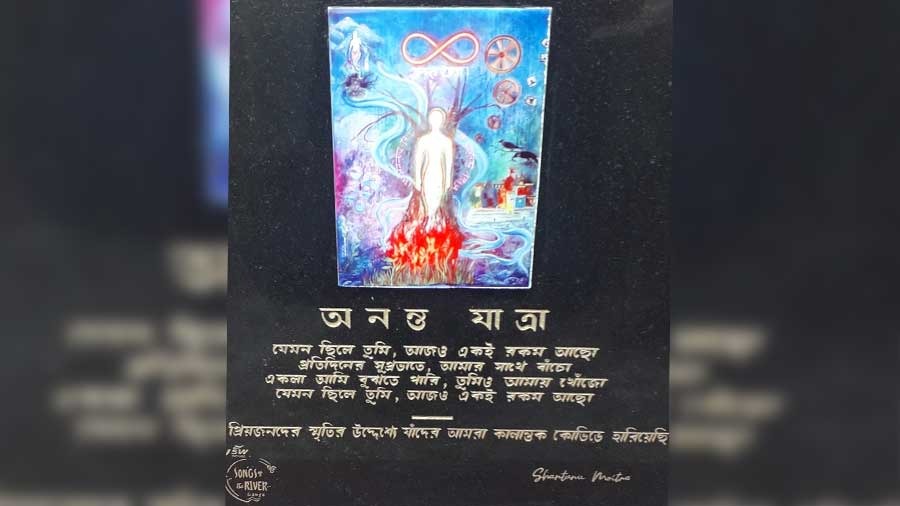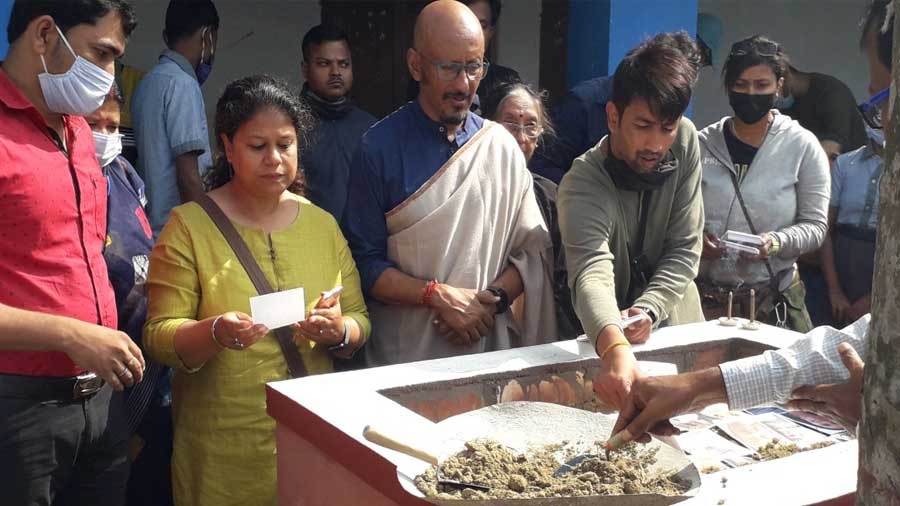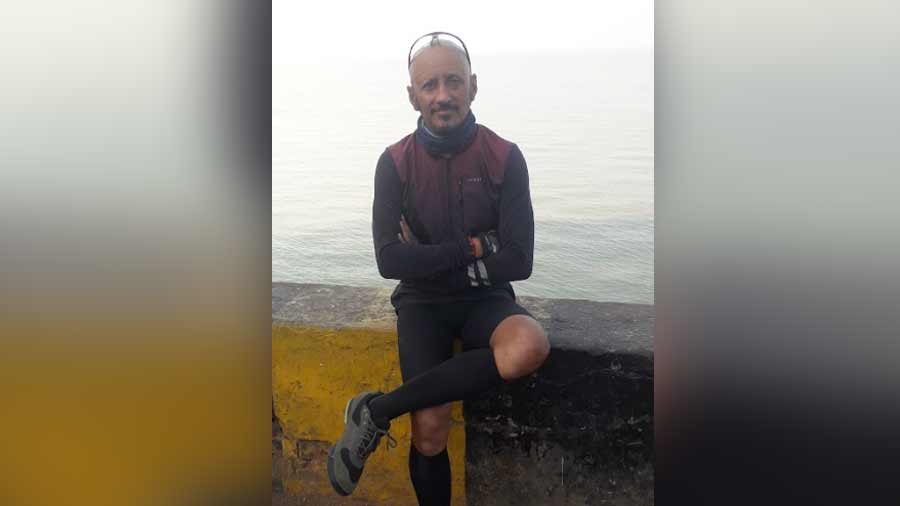Can you smell a photograph?
The members of Shantanu Moitra’s team, who were an integral part of the National Award winner’s recently concluded Anantha Yatra certainly could. As the photographs sent in by Moitra’s social media followers arrived at Diamond Harbour en route to the completion of his remarkable expedition from Gomukh to Gangasagar, everyone took turns to pick up a bunch of photographs and breathe in their aroma.
The photographs, which contained the faces of individuals lost to Covid-19, did not smell like normal photographs, which is to say they actually had a distinct smell. The smell was refreshing and vibrant, gentle yet stimulating. It was a smell that carried sacred overtones for anyone even remotely associated with pujas and festivals, for the photographs exuded the smell of tulsi (Holy basil), an omnipresent plant at religious occasions in India.
But why would photographs, numbering in excess of 700, which are supposed to mark Moitra’s attempt to pay homage to the victims of Covid-19, smell of tulsi? Because they were infused with tulsi seeds as part of the heart-warming innovation that converted the Anantha Yatra from a memorable journey to an endeavour with an indelible legacy. Quite literally.

Some of the photographs that were planted at the school Priyam Marik
The circle of life
“It all started with a gem of a person called Karan Rastogi, whom I met in Kanpur,” recalled Moitra. At the time, Moitra had already begun his once-in-a-lifetime adventure that involved cycling more than 3,000 kilometres in two months.
“I still lacked a greater meaning to what I was doing. I had just finished performing the last rites of my father in Varanasi. Since he was from Varanasi himself, the last rites had given me much-needed closure. But I was searching for something that could define the rest of my journey, something that wasn’t about me, but about something much larger,” said Moitra, his eyes gleaming with a sense of purpose.
Rastogi, who wanted to channelise his entrepreneurial energies for the betterment of society, had already impressed Moitra with one of his initial initiatives. This initiative entailed collecting all the flowers that go waste at Indian temples (and there are tons of them!) and manufacturing organic, eco-friendly agarbattis out of them. “What’s even better is that the agarbattis ended up being used at the same temples from where the flowers were picked up! The circle of life, as they say,” said Moitra.

Moitra poses with his family and team members at the conclusion of the planting ceremony Priyam Marik
Photographs with tulsi seeds
When Moitra told Rastogi about his Anantha Yatra and his intention to underline the collective humanity behind the suffering unleashed by Covid-19, the latter had an idea. Why not invite Moitra’s social media followers to send photographs and insert tulsi seeds into each of them? So that once those pictures are planted, they can grow and produce new life.
“I loved the idea straight away,” recalled Moitra. But things were easier said than done.
The first challenge was to infuse the photographs with the tulsi seeds without making them look bizarre in any way. Once Rastogi took care of that, the next issue was printing the photographs in a sustainable manner.
“Rubber solution can easily perform the trick we were looking for with the photographs. But the rubber solution isn’t environmentally friendly. We brainstormed for days about how to get this done, but to no avail.”
“Then, a few days before my journey was supposed to end, a friend of mine cracked it. He realised that there was a way to take the rubber out of the pictures,” explained Moitra, before proceeding to add, “The mistake we were making is that we didn’t think how long these pictures would last. Normally, a photograph would last for years, even decades, but for something like this, we don’t need that. Once the plants start growing, the photograph fades anyway. My friend picked up on that and decided that the rubber, which was meant to provide longevity to the photograph, could be eliminated. This meant we could print coloured versions that were eco-friendly. That way we could tick all the boxes!”
The photographs, which also included a portrait of Moitra’s father who passed away due to Covid-19 in May, were aggregated and taken to Shridham Gangasagar Swami Kapilananda Vidyabhaban, the site for the Covid memorial chosen by Moitra and his team.

A student from Shridham Gangasagar Swami Kapilananda Vidyabhaban offers her prayers in front of the memorial Priyam Marik
Plant the photos and watch them grow
At the Vidyabhaban, Moitra, along with his family and team members, planted the photographs in the soil at the top of the memorial, paving the way for them to germinate into fresh tulsi plants over time. The school students, who remained starstruck around the Bollywood music composer — think Parineeta to 3 Idiots — throughout, also participated, and have been entrusted to water these photographs every day.
“It is an honour for us to have the Covid memorial on our premises. I don’t think a memorial like this exists anywhere else in the country. We are grateful to Shantanu Moitra for selecting our school and we have tried to cooperate in every way to make the last part of his Anantha Yatra a resounding success,” observed Binay Krishna Mandal, the principal of Shridham Gangasagar Swami Kapilananda Vidyabhaban.

The Covid memorial at Shridham Gangasagar Swami Kapilananda Vidyabhaban Priyam Marik
On each side of the memorial is a special plaque, containing artwork and poetry. The artwork, done by the “extremely talented Ankita from Patna”, is fabulously intricate in its detail, and depicts the journey of the spirit from Gomukh to Gangasagar. The infinity symbol characterises the ceaseless nature of the journey, while subtle references to Covid-19, the cycle of life and the elements of the universe, make the painting a thoroughly thought-provoking creation.
The poem, appropriately penned for the occasion, is by Moitra’s fellow cyclist for the last leg of his expedition, Samrat Moulik.
‘A sense of acceptance’
“Looking at this memorial made me feel something I haven’t felt ever since I lost my husband. I think, at last, there was a sense of acceptance, realising that so many others have also lost their near and dear ones. That somehow, somewhere, we are all in this together. I am truly touched by how everyone in my son’s wonderful team has come together to make this happen. It definitely means a lot to me,” said Manju Moitra, Shantanu’s mother, who created a magnificent alpona around the memorial in no time.
Even though Shantanu Moitra’s expedition came to an end after 60 days of relentless riding, the memorial he has helped build will last for a lifetime and beyond, allowing new life to prosper even as it remembers those who are no more.

